MARIANI’S
Virtual
Gourmet
March
19, 2023
NEWSLETTER
ARCHIVE
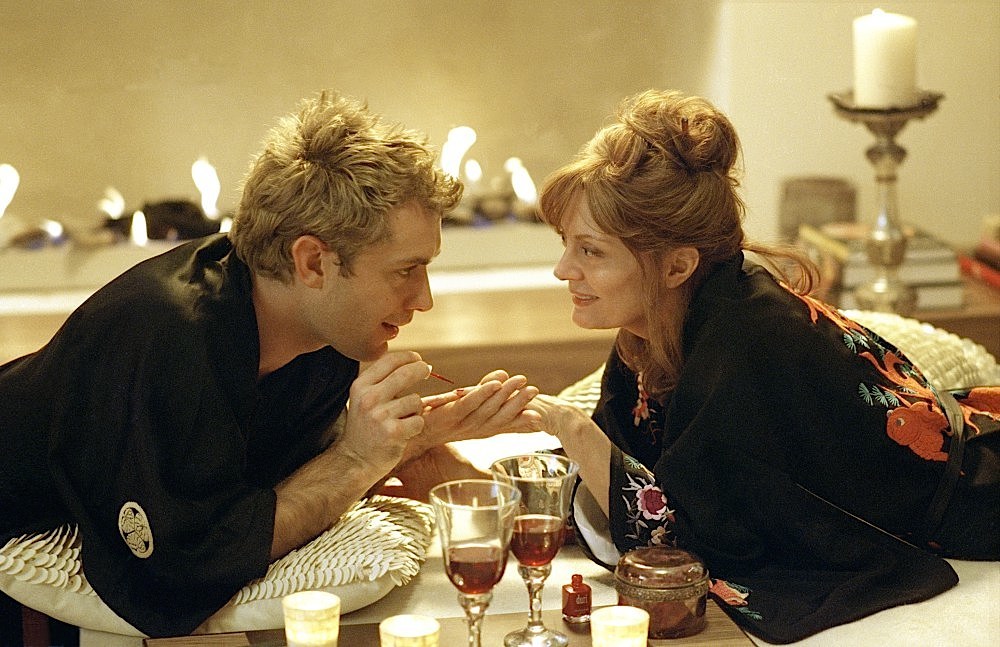
Jude Law and Susan Sarandon in "Alfie" (2004)
Jude
THIS WEEK
WHAT'S NEW IN DC?
By Geoff Kalish
NEW YORK CORNER
LE ROCK
By John Mariani
GOING AFTER HARRY LIME
CHAPTER TWELVE
By John Mariani
NOTES FROM THE WINE CELLAR
WINES FOR EARLY SPRING
By John Mariani
 Scognamillo,
owner of the famous celebrity Theater
District Restaurant PATSY's. Go to: WVOX.com.
The episode will also be archived at: almostgolden.
Scognamillo,
owner of the famous celebrity Theater
District Restaurant PATSY's. Go to: WVOX.com.
The episode will also be archived at: almostgolden.
By Geoff Kalish
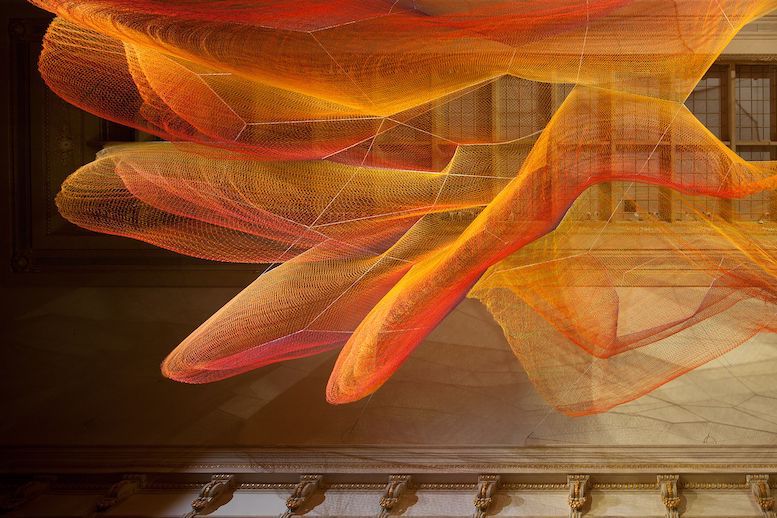
"1.8 Renwick" Janet Eckleman (2015)
A recent
visit to Washington, DC emphasized the point
that more than a city of government office
buildings, monuments and insurrections, the
U.S. capital presents visitors with numerous
wonderful museums and a wide variety of
reasonably priced, excellent restaurants. In
addition, it features a large assortment of
lodging facilities within walking distance of
the main attractions.
We
found the new Salamander Hotel (formerly the
Mandarin Oriental) a great place to stay from a
standpoint of elegance, facilities, price and
location. Situated along the Potomac River,
within easy walking distance of the National
Mall, major museums and the new “wharf area,”
the hotel offers a plush spa, indoor swimming
pool and 373 elegantly modern, spacious rooms
with a number overlooking the Tidal Basin and
the Jefferson and Lincoln memorials. And,
while at this time the hotel restaurant only
offers breakfast and lunch, there’s a more than
adequate 24- hour room service menu. And another
feature is top-notch Concierge service with sage
advice and directions to museums and
restaurants.
As for museums, we visited nine in total
with the following highlights: The West Building
of the National Gallery of Art features
paintings and sculptures from
the 13th to early 20th century, including a room
of Rembrandts, numerous works by Tiepolo, a room
containing a series of paintings by Louis
Maurice Boutet de Monval on the life of Joan of
Arc and a bevy of paintings by French
impressionists, including Monet, 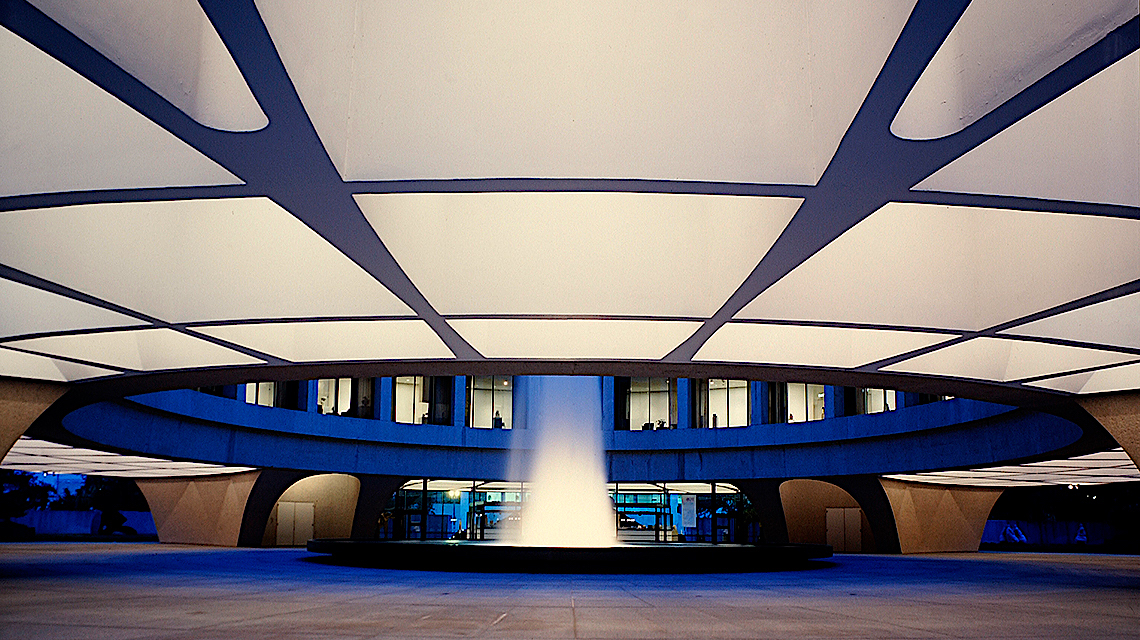 Degas,
Pissaro,
Renoir and Gaugin.
Degas,
Pissaro,
Renoir and Gaugin.
Also not to be missed is the sculpture
garden, just outside the museum, containing
works by contemporary artists like Tony Smith
and Mark di Suvero as well as classics from
Calder and Miro. The Hirshhorn Museum—which
I call “The
Museum of Way Out Art,” whose current exhibit of
rooms by Yayoi Kusama (“One With Eternity”—is
open through the Spring, along with a permanent
room by Laurie Anderson.
Adjacent to the Hirshhorn there’s the National
Museum of Asian Art (Sackler Gallery),
with a thought-provoking exhibit of contemporary
photography from India entitled “Unstill
Waters,” that explores the social impact of
recent environmental changes.
 At
the Smithsonian National Museum of American
History there’s ongoing exhibits on food
and transportation with a focus on the
involvement of African Americans in these two
industries; and at the Smithsonian National
Museum of African Art there’s an extensive
exhibit about “Nollywood,” the growing Nigerian
movie industry with an output of nearly 2,500
films a year.
At
the Smithsonian National Museum of American
History there’s ongoing exhibits on food
and transportation with a focus on the
involvement of African Americans in these two
industries; and at the Smithsonian National
Museum of African Art there’s an extensive
exhibit about “Nollywood,” the growing Nigerian
movie industry with an output of nearly 2,500
films a year.
The Smithsonian National Air &
Space Museum offers an insightful exhibit
of the invention of the first ever “heavier than
air” manned flight by the Wright Brothers.
There’s an exhibit about “America’s Response to
the Holocaust” at the National Holocaust Museum
examining the motives, pressures and fears that
molded America’s response to Nazism and the
holocaust.
A not to-be missed exhibit at the Renwick
Gallery of the Smithsonian American Art
Museum (near the White House) is Janet
Eckleman’s installation of fibers and lights,
exploring the interconnection between humans and
the physical world. And, at the Phillips
Collection, in Dupont Circle, there’s an
impressive array of 70 paintings
of little-known Italian impressionist painter
Giuseppi de Nittis.
RESTAURANTS
Mi Vida
98 District Square SW
Located in the new “wharf area,” this
400-seat establishment (there’s another on 14th
Street) serves upscale 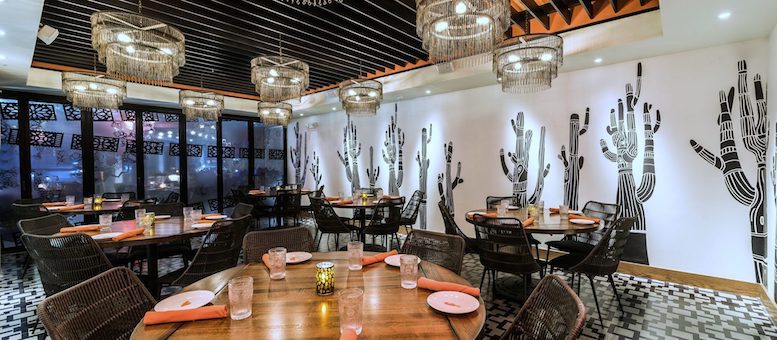 Mexican
cuisine in a number of surprisingly cozy, quiet
spaces. An order of guacamole with crab and
shrimp salpiçon,
habanero and cilantro ($2), that had just the
right about of tongue-tingling spice was served
with a large bowl of crisp, addictive house-made
chips. We also shared an order of tacos stuffed
with crispy cod bathed in tartar sauce and
avocado salsa, ($29)
Mexican
cuisine in a number of surprisingly cozy, quiet
spaces. An order of guacamole with crab and
shrimp salpiçon,
habanero and cilantro ($2), that had just the
right about of tongue-tingling spice was served
with a large bowl of crisp, addictive house-made
chips. We also shared an order of tacos stuffed
with crispy cod bathed in tartar sauce and
avocado salsa, ($29)
For main courses we chose a plate of
whole roasted butterflied branzino, half coated
with red and half with green spicy adobo and
accompanied by black beans ($36) and an order of
enchiladas filled with braised chicken breasts
covered in a creamy combination of buttery
chihuahua cheese and tomatillo sauces ($22). We
concluded with a trio of fruity sorbets ($8) and
accompanied the meal with a bottle of 2016
Bodegas Elias Mora “Crianza” Toro wine that had
bright flavors of ripe cherries and cassis.
RPM Italian
650 K St. NW
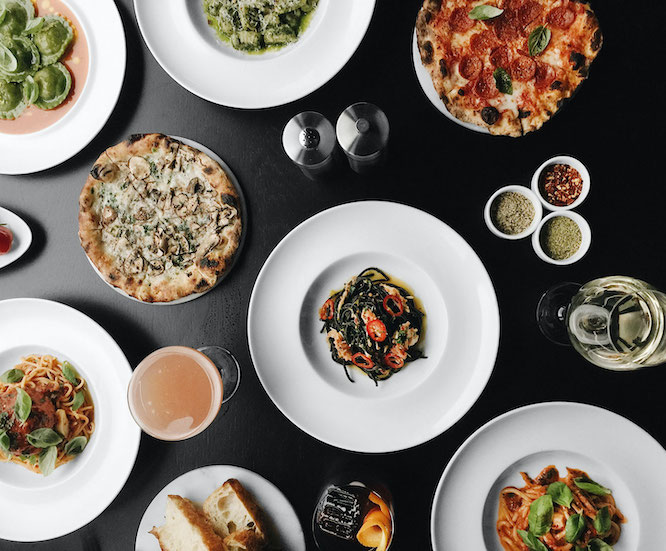 Located in the city’s Mount Vernon
neighborhood, this restaurant, part of a small
chain out of Chicago, features a sleek, modern
interior, upscale Italian fare and attentive
professional service. Moreover, there’s an
excellent wine list offering some exceptional
bottles at somewhat reasonable prices.
Located in the city’s Mount Vernon
neighborhood, this restaurant, part of a small
chain out of Chicago, features a sleek, modern
interior, upscale Italian fare and attentive
professional service. Moreover, there’s an
excellent wine list offering some exceptional
bottles at somewhat reasonable prices.
We started with appetizers of a moist,
Waygu beef carpaccio ($23) rolled up with crisp
arugula, topped with Parmesan crisps and
drizzled with truffle aïoli ($12), as well as a
heady cremini mushroom wood-oven pizzette. We
followed that with a salad of thinly shredded
Brussels sprouts mixed with avocado and mildly
spicy “Mamma Lil” peppers ($14).
For main courses we chose an order of
spicy King crab shards atop briny-flavored squid
ink spaghetti ($28), and an order of large,
dewy sea scallops coated with a pistachio pesto
($34).
We
accompanied the meal with a bottle of 2019
Passarosso Etna Rosa from Nerello Mascalese,
gown in various vineyards along the slope of
Mount Etna, that showed a bouquet and flavor of
cherries and pomegranate with a touch of acidity
in its memorable finish. And in lieu of dessert
we shared a glass of sweet, honeyed 2019 Maculan
Torcolato de Breganze.
NEW YORK CORNER
LE ROCK
332-258-8734
By John Mariani
Interior and food photos by Gentl + Hyers

Rockefeller
Center has been one of New York’s glories
since its beginnings in 1933 and completion in
1939, a daunting rebuke to that decade’s
Depression proving that, with its sunken ice
rink and ring of international flags, Radio
City Music Hall and stunning limestone and
glass skyscrapers, it is the epitome of High
Art Deco.
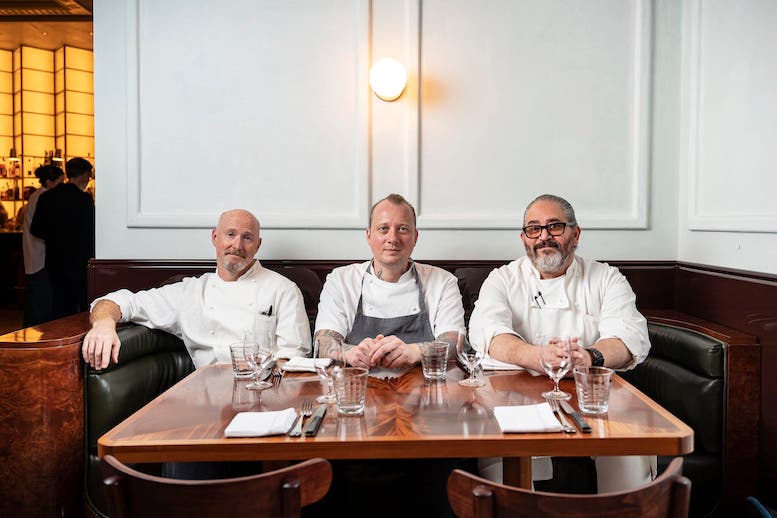 Over the
decades there have been many fine restaurants,
including the Rainbow Room and the Sea Grill,
within its 22 acres, but in the past year all
previous ones have been replaced with brand new
ones by the Center’s current owners, Tishman
Speyer, including Le Rock, which is located in
one of the finest buildings to the north of the
ice rink. Its
façade has some wondrous bas-relief sculptures.
Over the
decades there have been many fine restaurants,
including the Rainbow Room and the Sea Grill,
within its 22 acres, but in the past year all
previous ones have been replaced with brand new
ones by the Center’s current owners, Tishman
Speyer, including Le Rock, which is located in
one of the finest buildings to the north of the
ice rink. Its
façade has some wondrous bas-relief sculptures.
Le Rock is owned by Lee Hanson and Riad
Nasr, who three decades ago ran the kitchen at
Balthazar, then opened their own acclaimed
Frenchette’s in TriBeCa, which toed much the
same line of brasserie fare. Le Rock is much
larger, with 130 seats (the space was previously
Brasserie Ruhlmann), now with terrazzo floors,
pastel colors of blue and dusty pink, burled
wooden tables, green leather banquettes,
beautiful verdigris metalwork and a cast iron
bronze bar.
A press release calls Le Rock “quietly
grand,” but all those hard surfaces and very
tall ceilings make it intensely loud and
conversation is difficult, especially since the
space is almost always jammed with two or three
turnovers a night. Buffering would help, as
would tablecloths. And turning off the booming
music would, too.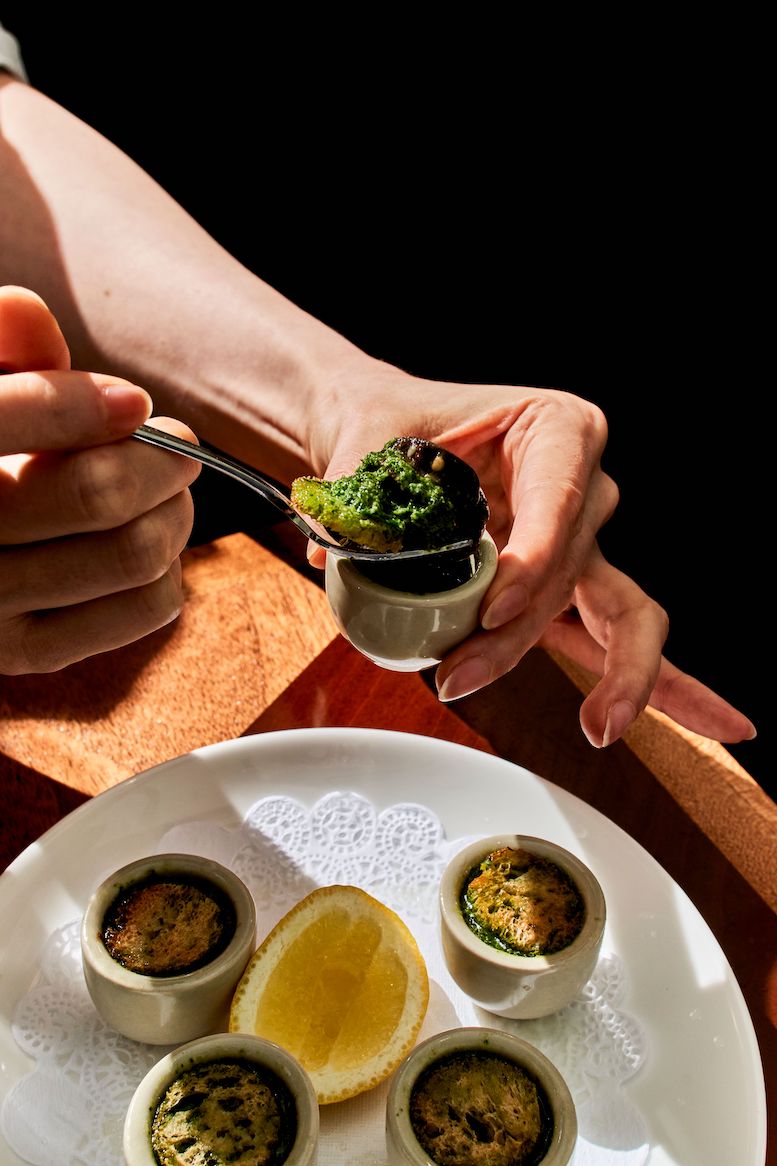
Hanson and Nasr, together with chef
Walter Stern, offer a fairly long menu largely
made up of brasserie/bistro classics you’ll find
elsewhere in town, but a good number
you almost never do. I’m told the original menu,
upon Le Rock’s opening last summer, was all in
French, though now it’s mostly in English. It
wouldn’t hurt, however, to
give translations for unfamiliar dishes like cervelle de
canut (a Lyonnaise cheese spread; $8) and tablier de
sapeur (fried tripe; $8).
The menu is categorized under “Cette
Semaine” (“this week”), an assortment of small
bites that when I visited included those two
dishes above along with wonderful Moroccan
crispy pastries popular along the French Riviera
called barbajuans
($13), stuffed with pumpkin, rice, leeks and
padano cheese.
One is advised to pop them in your mouth
(once they cool down) or risk a spurt of hot
juices down your chin.
The ramekin of creamy chicken liver
mousse with a glaze of Port jelly ($8) goes well
with the first-rate baguette bread from
Frenchette’s, also ideal for spreading on the
ivory-colored brandade
of cod ($8) that is admirably not at all fishy.
Best of all, the amuses
are the marinated sardines escabèche
($15), which, again not fishy, are some of the
most flavorful I’ve had in a very long time. The
flesh slips off the bone and tantalizes the
palate in one bite.
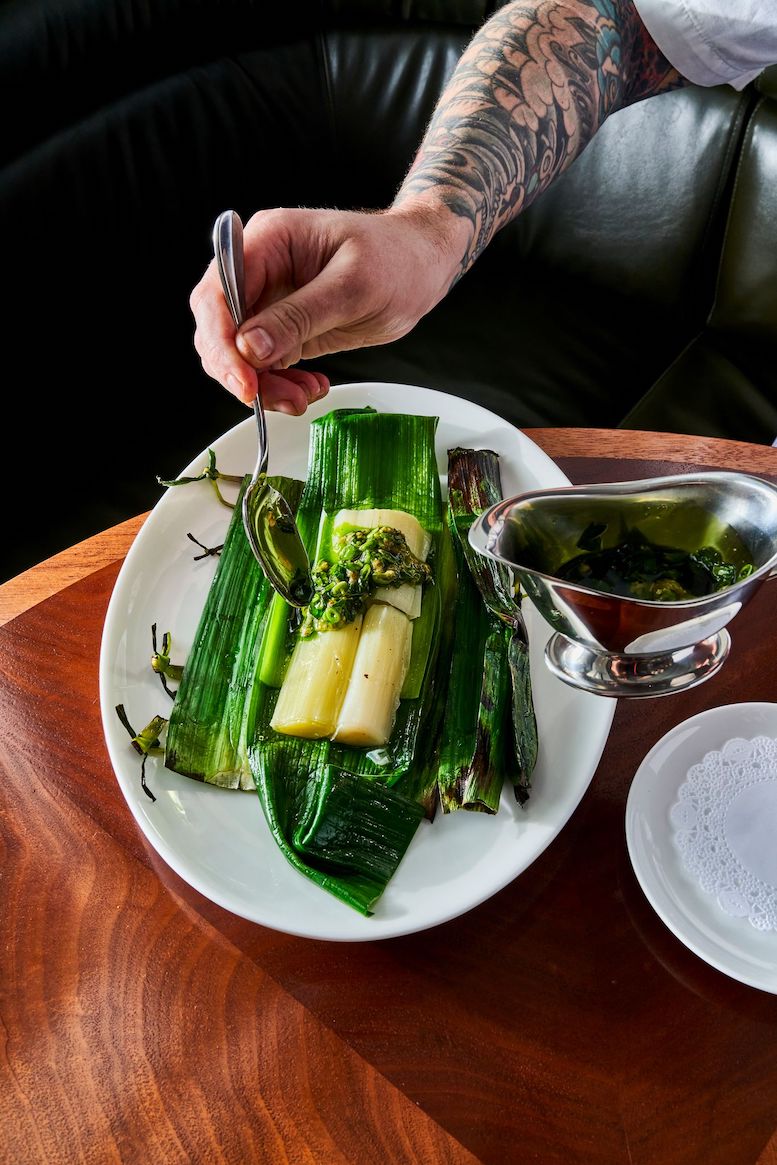 Next
are the appetizers, none of which is large
enough for sharing. Agnolotti ($24)
were tender, buttery little packets of trumpet
mushrooms and chopped chestnuts. Escargots
bourguignons ($26) were about par for the
course, as were rather pricey grilled leeks
vinaigrette ($26). But the onion soupe
gratinée ($26)—a requisite dish for every
brasserie/bistro—was surprisingly bland, pale in
color, with little indication of the onions
being caramelized to a deep, dark brown.
Next
are the appetizers, none of which is large
enough for sharing. Agnolotti ($24)
were tender, buttery little packets of trumpet
mushrooms and chopped chestnuts. Escargots
bourguignons ($26) were about par for the
course, as were rather pricey grilled leeks
vinaigrette ($26). But the onion soupe
gratinée ($26)—a requisite dish for every
brasserie/bistro—was surprisingly bland, pale in
color, with little indication of the onions
being caramelized to a deep, dark brown.
Main courses are heartier still. The best
I tried was the fat boudin
blanc, juicy white veal sausage over
tangy-sweet braised cabbage ($38). I sampled two
fish dishes, both nicely cooked, including a cod
with truffled salsify  noisette
($52) and a delicious halibut cooked in vin jaune (“yellow
wine” from the Jura) cream sauce that suffused
the flesh ($56). Poulet roti
espelette ($42) was first brined , then
dusted with espellette peppers, pimento,
mushroom powder and sugar that caramelized the
skin to a mahogany color, served with
irresistible panisse
chickpea fritters .
noisette
($52) and a delicious halibut cooked in vin jaune (“yellow
wine” from the Jura) cream sauce that suffused
the flesh ($56). Poulet roti
espelette ($42) was first brined , then
dusted with espellette peppers, pimento,
mushroom powder and sugar that caramelized the
skin to a mahogany color, served with
irresistible panisse
chickpea fritters .
Desserts, by Mariah Neston and Michelle
Palazzo, do a slight turn on classic
profiteroles ($16) that makes them even better
than usual in texture and the flavor of the ice
cream. I would never suggest that the soupy
hazelnut soufflé I was served that night ($20)
always comes that way, which was a shame because
the flavor was fine.
The wine list has about 200 labels that
include a lot of interesting regional bottlings
collected by sommelier/wine director Jorge Riera
(who should upgrade his way-too-casual dress),
though I wish there was a balance of wines below
$100 with those way above that price.
 Service at Le Rock from the greeting to
the leaving is very friendly, though, like just
about every restaurant these days, the staff
seems stressed by having too many tables and not
enough waiters.
Service at Le Rock from the greeting to
the leaving is very friendly, though, like just
about every restaurant these days, the staff
seems stressed by having too many tables and not
enough waiters.
Le Rock is, for the moment, a big hit and
should continue to be, given its location within
the urbane heart of Manhattan. (Reservations are
tough to come by at some peak hours, but
walk-ins are welcome.)
In
a post-Covid world, the enthusiasm of people to
dine out in a space like Le Rock is a wondrous
antidote to those who would wait in a long line
to get into a Brooklyn taqueria. As always, New
York proves that sophisticated dining of the
kind so many lament is dying is a vibrant part
of its civic soul.
Open
for lunch and dinner Tues.-Sat.
❖❖❖
GOING AFTER HARRY LIME
By John Mariani
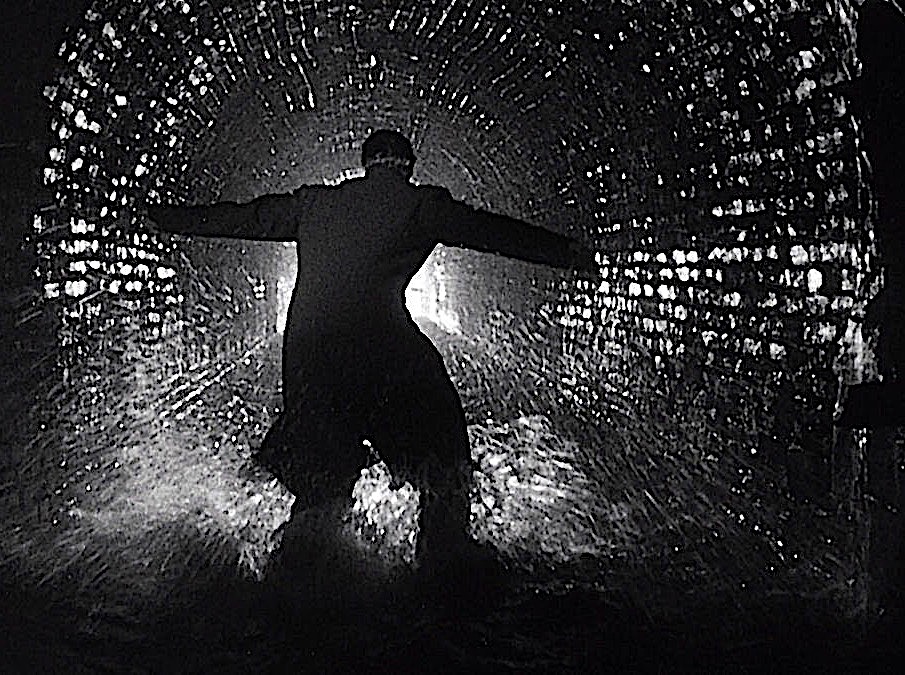
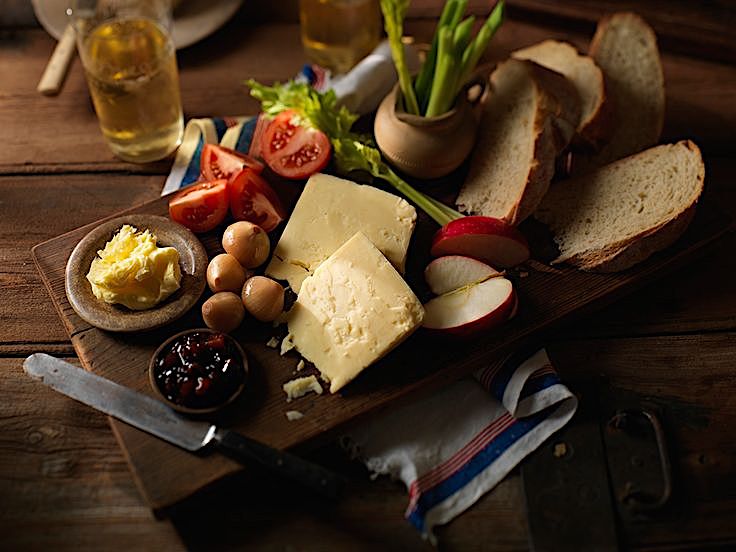 For the time being David felt no
need to go back to the National Archives. He
was simply looking forward to dinner with
Katie and a discussion of how to proceed. He
couldn’t offer her much support in her quest
but eagerly wracked his brain as to how he
might help her come to one decision or the
other.
It then occurred to him that if they
could get in to see someone from MI6 who
might share a dossier on Philby or any of
those names he’d copied from the American
and British archives, it would at least make
for something of a coup on Katie’s part. As
for himself, David ‘s only interest was in
where the leads went and how he could make
it easier for Katie to follow them.
For the time being David felt no
need to go back to the National Archives. He
was simply looking forward to dinner with
Katie and a discussion of how to proceed. He
couldn’t offer her much support in her quest
but eagerly wracked his brain as to how he
might help her come to one decision or the
other.
It then occurred to him that if they
could get in to see someone from MI6 who
might share a dossier on Philby or any of
those names he’d copied from the American
and British archives, it would at least make
for something of a coup on Katie’s part. As
for himself, David ‘s only interest was in
where the leads went and how he could make
it easier for Katie to follow them.
In his hotel room David made a call to
Gerald Kiley at Interpol in New York.
“Cheerio,” said Kiley answering the
phone. “What’s up, David?”
“Sorry to report, not much,” said
David. “I haven’t found much in the archives.
Katie spent the day with one of Greene’s
old writer friends. I’ve
no idea what she might have found. Anyway,
Gerry, I know this is a long shot, but do you
think there is any way I could talk to an MI6
agent, even a bureaucrat, who could show me
dossiers on a few people of interest?”
“David, I know a few names, but, even
if I vouch for you, there’s no way they’re
going to share that stuff with you. You are no
longer a cop and you are no longer on a case.
And from what you tell me Katie doesn’t even
have a confirmed assignment from her magazine.
They’re not going to talk to you.”
“Not even out of professional
courtesy?”
“That and a couple of euros won’t get
you on the subway.”
“They’re not using the euro here. They
still use pounds and pence. And it’s called
the Underground, not the subway."
“Whatever. British intelligence isn’t
going to talk to you. But, listen, I know
you’re not going to want to do it, but why not
call your old pal Frank English at the F.B.I.?
Maybe he has a contact with an ex-British
intel guy.”
David rolled his eyes and sighed
audibly. Frank English had once been a
professional and personal friend of David when
he was on the NYPD, but English had seriously
broken his trust with David during the Capone
case and it had soured the relationship.
Nonetheless, English had tossed David a bone
in the Vermeer case. Maybe he’d do it again.
“I guess it’s worth a try,” said David.
“Maybe patch things up somehow. Thanks,
Gerry.”
“Anytime. Bring me back one of those
good English umbrellas.”
“See what I can do.”
It was seven
o’clock in London but two in Washington, where
English worked, so David made the call. He
got an answering machine and David thought,
like a high school kid asking for a date, of
hanging up without leaving a message. But
English’s phone would already have recorded
David’s cell phone number, so David said,
“Frank, David Greco. Listen, I’m in London
snooping around on a project with Katie Cavuto
and I could use your help. Can
you call me back tomorrow any time after nine
your time? Appreciate it.”
David went downstairs and Katie was
already there, dressed in black slacks, white
blouse and a camel-colored blazer. She was
wearing what David used to call Chelsea boots
when he was a teenager in the Sixties.
“Looking very, what’d they used to call
it? Mod?” he said.
“Maybe a touch. Picked up the boots
this afternoon at a place on Sloane Street.”
“So where are we eating?” he asked, not
really caring what she chose, even Indian.
“How about an English pub with good
food?”
“There is such a thing?”
“According to this book on the best
pubs, quite a lot,” she said, opening a thick
chunk of a paperback book called The Good Pub
Guide. “This one here—Ye Olde Cheshire
Cheese—is supposed to date back to the 17th
century. Charles Dickens, Mark 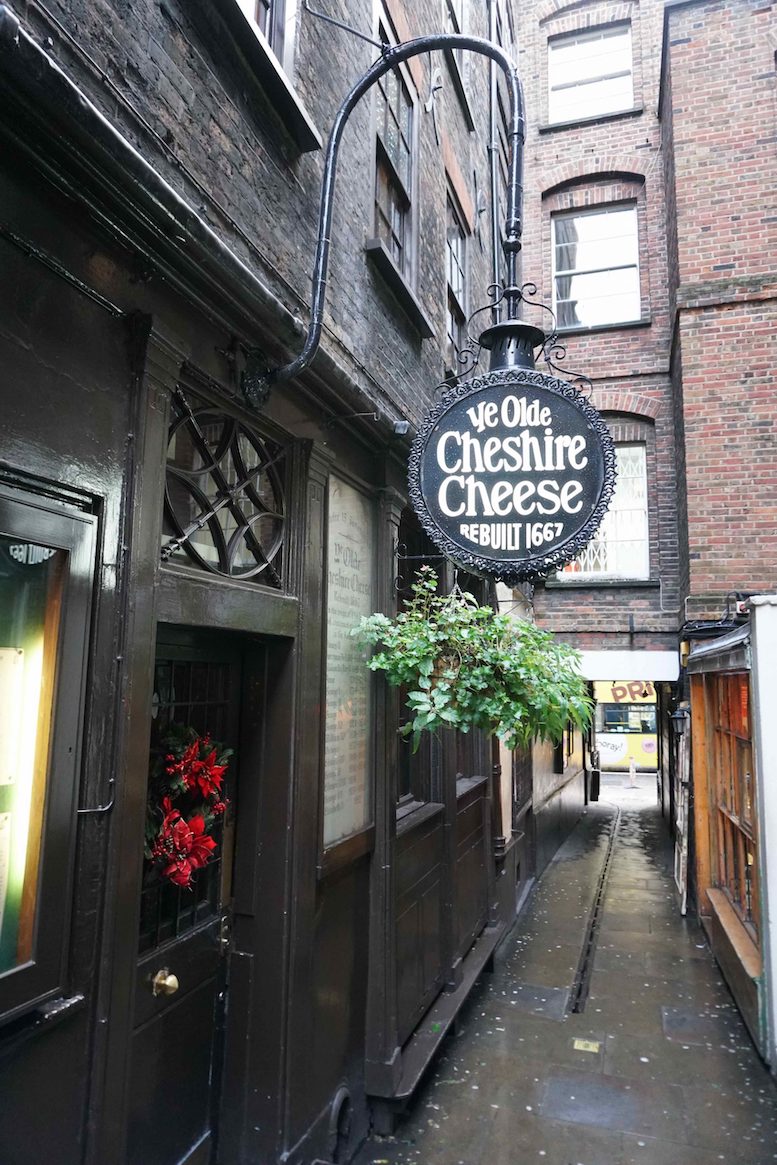 Twain, Arthur Conan
Doyle all were customers. Wanna
try it?”
Twain, Arthur Conan
Doyle all were customers. Wanna
try it?”
“If the beer’s not too warm, why not?”
Ye Olde Cheshire Cheese was located on
Fleet Street and when David and Katie arrived
around eight, the place was packed. Spread
over four levels with fireplaces and bars and
dungeon-like vaults downstairs, it looked just
as all American visitors hope a London pub
will. Katie and David took a snug corner table
against the wall. Somewhere a parrot was
making noise. David seemed lost in the beer
and ale options, Katie asked about wines by
the glass but ended up ordering a Guinness—her
first—and David joined her.
They ordered pub food: Shepherd’s pie,
fish and chips and a plate of cheeses. They
spoke for a good half hour about London before
getting down to Graham Greene.
“So how’d your day go?” asked David.
“That guy Evelyn—pronounced
‘Ee-vlinn’—was very, very interesting,” she
answered. “Kept me there for two hours
talking, mostly about his own work, but he
seems to have known Greene very well and gave
me a 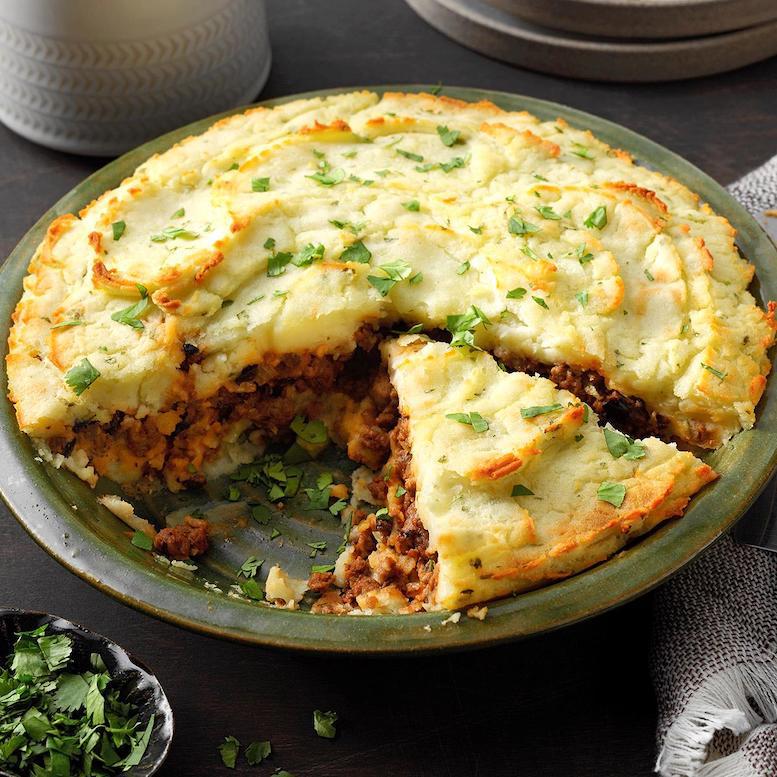 lot of insight.
lot of insight.
“Like what?”
“A lot of what he said corroborated
what I knew about Greene’s paranoia, Catholic
guilt, and unbreakable sense of loyalty to
friends, even if the friend had character
traits his other friends abhorred.”
“Say anything about Philby?”
“I asked him, of course, and he spoke
as a writer, to the degree that all fictional
characters are composites unless the author’s
writing a flat-out satire or parody of a
public figure. He said he believed Greene knew
more about
Philby than he ever let on and both men went
to their graves protecting each other—Greene
far more so than Philby, whom Evelyn thought
had Greene in his pocket. Anyway, since Philby
was exposed so many years after The Third Man
came out, Evelyn didn’t see much of a link.
Certainly nothing direct.”
David had felt that was how the
interview with Dawes was going to go and hated
to tell Katie he hadn’t turned up much else
beyond some overlapping lists of black market
criminals working in Vienna after the war.
“The thing is this, Katie. If we keep
Philby out of the investigation entirely,
we’ve still got a lot of potential contestants
for the character of Lime on those lists. The
trouble is, can we”—he didn’t want to say
“should we”—“continue to try finding the ones
on the list who got away? Or even the ones
that didn’t?
I was told by the woman at the Archives
that the outcomes of the arrests and
prosecutions are most likely deep in court
archives, somewhere not easy to find them. And
it would take weeks, if not months. We’ve got
to ask ourselves how much time we can afford
to pursue them.”
Katie was finishing her Guinness.
“Amazing how it keeps its head,” she
said of the famous foam the beer produced.
“Well, I guess if we eliminate Philby or put
him to the side, we’d have to figure out one
of those composites Evelyn spoke about.”
“We did it all the time in police
investigations, then whittle it down, toss out
the ones who couldn’t possibly have committed
the crime, and in the end, well, sometimes
we’d get lucky, get a tip, and things started
to gel around one individual we’d already
looked at a dozen times. But, of course, you
and I don’t have the resources of the NYPD.”
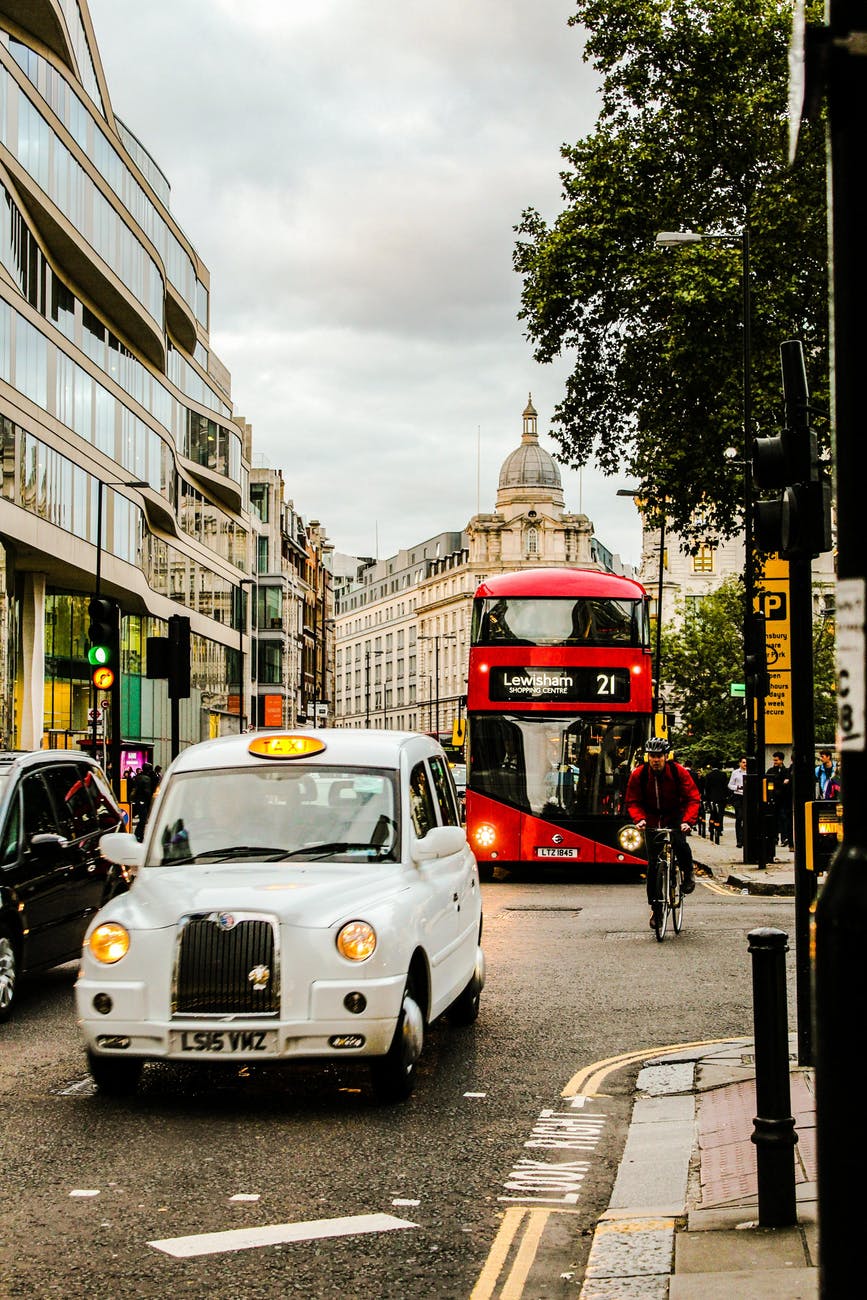 Katie smiled broadly, maybe a little
lightheaded, raised her empty glass and said,
“No, but we have David Greco, NYPD’s best
detective!”
Katie smiled broadly, maybe a little
lightheaded, raised her empty glass and said,
“No, but we have David Greco, NYPD’s best
detective!”
David said, “Thanks, but, even if that
were remotely true, I still had tremendous
resources behind me. Here it’s just you and
me.”
Which suited David just fine. A week in
London with Katie. So he tried to put a
positive spin on things, saying, “Listen, I’ve
got a call in to Frank English at the F.B.I. Maybe
he can give us some contact at MI6. Gerry
Kiley said there’s no way they’d open any
dossiers for us without official approval. But
let’s see what Frank says, if, that is, he
calls me back.”
It was now past ten and a light rain
was coming down outside the pub. Neither of
them had an umbrella but David had a raincoat
and gave it to Katie.
“You can lay it down in a puddle if you
have to get across it,” he said, and she bowed
her head and said, “Thank you, m’lord.”
Getting a cab was not easy but they
finally snared one and headed back to the
hotel.
“So, get a good night’s sleep, Katie.”
“La-dee-dah, tomorrow is another day.”
“And we get to spend it in London. I’ll
let you know if I hear from Frank.”
Both of them dozed off in
their beds thinking this had all been a nice
idea, didn’t cost them much, and that, even if
they’d hit a dead end, it was still worth
it.
© John Mariani, 2016
❖❖❖
WINES FOR AN EARLY SPRING
By John Mariani
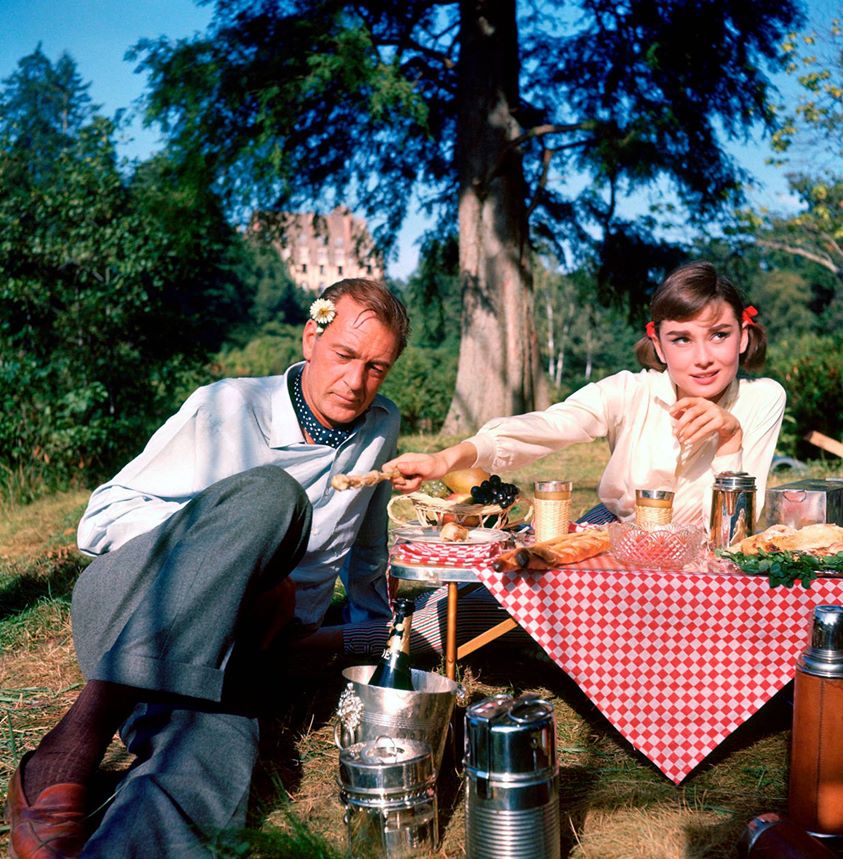
The crocuses are poking their way up
through the earth, it’s still light at six o’clock
and there is a whiff of springtime in the morning
air. Which means the foods of springtime will soon
be in the markets and stalls—ramps, asparagus,
shad roe, peas, strawberries, mint, baby lamb and
more. And that offers the opportunity to try new
wines that go with these foods. Here are some of
my picks for the coming months.
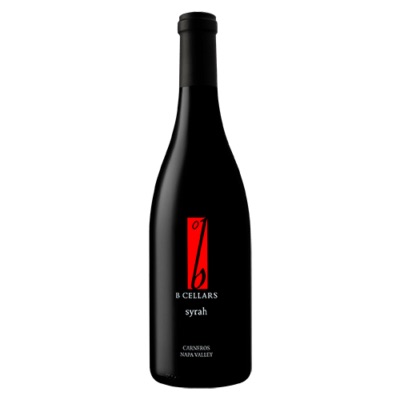 B Cellars 2020 Hudson
Vineyard Syrah ($98)—Just released, this
is not a wine from New York’s Hudson Valley but from
Carneros in Northern California and represents a
high point for a grape too often neglected, despite
its prevalence in Rhône Valley wines. It’s pricey,
but it’s quite lush and very expressive of the
varietal character. It would be ideal with roasted
baby lamb or Easter ham.
B Cellars 2020 Hudson
Vineyard Syrah ($98)—Just released, this
is not a wine from New York’s Hudson Valley but from
Carneros in Northern California and represents a
high point for a grape too often neglected, despite
its prevalence in Rhône Valley wines. It’s pricey,
but it’s quite lush and very expressive of the
varietal character. It would be ideal with roasted
baby lamb or Easter ham.
Cockburn’s Special
Reserve ($20)—I am always amazed
at the low prices for excellent Port, and—although I
am among many bewildered by all the categories made
in the region—this Reserve Port from a producer
established in 1815 is a middle-ground between light
Ruby Port and big, bold Vintage Port. So you get
body and tantalizing fruit from a Port aged four to
five years, rather than ten or twenty. It is,
therefore, delicious as an accompaniment to all
kinds of cheeses.
Paul Hobbs Goldrock
Estate 2019 Pinot Noir ($90)—Sonoma is Pinot Noir
country and Hobbs’s Goldrock Estate, at 550 feet
above sea level, is located as far west as you can
go, giving its vineyards the cooling effect of the
Pacific Ocean. That helps tame the over-ripeness the
grape often achieves under the California sun, so
this wine has more nuance and levels of fruit,
tannin and acid. With a spring chicken (if such a
thing exists) it is a fine choice.
Perla Terra Barolo
2018 ($45)—Made by Dalla Terra
from lots in Piedmont’s La Morra, Novello, Monforte
d'Alba, Grinzane Cavour and Verduno regions, this
blend is a younger, lighter style of Barolo,
spending 18 months in oak barrels of varying age,
then microfiltered and emerging at a sensible 14%
alcohol. Thus, it is a very drinkable Barolo
throughout an alfresco dinner. Only 20,000 bottles
are made, so this is a very reasonable price.

Open Claim Vineyards
Chardonnay 2019 ($75)—Willamette Valley
Chardonnays tend to be less woody and sweet than
those made south of Oregon, and Open Claims is the
latest winery to open in the state’s newest sub-AVA,
Mt. Pisgah, Polk County. Owners Brett and Marnie
Wall, along with winemaker Tony Rynders, make only
Chardonnay and Pinot Noir on 55 acres. Their wines
are sold through allocation only because of small
production. At 13.5% alcohol it is in a sweet spot
where the varietal shows its mettle without
intrusive flavorings. It would be superb with
spring’s salmon or shad roe.
Fiddlehead Cellars
2017 ‘Sweetie’ Late Harvest Grüner Veltliner, Sta.
Rita Hills ($35)—Grüner Veltliner is
not among my favorite table wines, but this
dessert example from Santa Barbara by winemaker
Kathy Joseph won me over. It’s a late-harvest wine,
meaning the sugars are intensified, and it is
delightful all on its own after dinner or with any
lighter dessert like fruit pies or strawberries and
cream.
de Negoce, Lot 250
“Hillside” Rutherford Cabernet Sauvignon ($19)—Cameron Hughes has
made a success of buying lots of wines and (often)
slashing prices, and here is a wine that once listed
at $65 and can now be bought for $19. The wine is
from Washington State, made from “pre-assembled barrel
lots of Cabernet Sauvignon from some of Red
Mountains finest vineyards like Ciel du Cheval,
Quintessence, and Klipsun not to mention the
producer's own estate vineyard.” The
alcohol is a little high, but if you like brawny
Cabs and good spice, this blend of 85% Cabernet
Sauvignon, 10% Merlot, 2% Malbec, 1% Cabernet Franc,
1% Syrah and 1% Petite Verdot has plenty going for
it. With steaks on the grill it works well.
❖❖❖
 AND
THEN HE WONDERS WHY
AND
THEN HE WONDERS WHY
STARBUCKS IS NOT POPULAR IN
ITALY
The world's
largest coffee chain Starbucks is launching
a line of olive oil-infused drinks in Italy.
Founder and CEO Howard Schultz (left) says
on the company website, "Now, there's going to be
people who say, olive oil in coffee? But the proof
is in the cup. In
over 40 years, I can't remember a moment in time
where I've been more excited, more enthused."
❖❖❖
Any of John Mariani's books below may be ordered from amazon.com.
 The Hound in Heaven
(21st Century Lion Books) is a novella, and
for anyone who loves dogs, Christmas, romance,
inspiration, even the supernatural, I hope you'll find
this to be a treasured favorite. The story
concerns how, after a New England teacher, his wife and
their two daughters adopt a stray puppy found in their
barn in northern Maine, their lives seem full of promise.
But when tragedy strikes, their wonderful dog Lazarus and
the spirit of Christmas are the only things that may bring
his master back from the edge of despair.
The Hound in Heaven
(21st Century Lion Books) is a novella, and
for anyone who loves dogs, Christmas, romance,
inspiration, even the supernatural, I hope you'll find
this to be a treasured favorite. The story
concerns how, after a New England teacher, his wife and
their two daughters adopt a stray puppy found in their
barn in northern Maine, their lives seem full of promise.
But when tragedy strikes, their wonderful dog Lazarus and
the spirit of Christmas are the only things that may bring
his master back from the edge of despair. WATCH THE VIDEO!
“What a huge surprise turn this story took! I was completely stunned! I truly enjoyed this book and its message.” – Actress Ali MacGraw
“He had me at Page One. The amount of heart, human insight, soul searching, and deft literary strength that John Mariani pours into this airtight novella is vertigo-inducing. Perhaps ‘wow’ would be the best comment.” – James Dalessandro, author of Bohemian Heart and 1906.
“John Mariani’s Hound in Heaven starts with a well-painted portrayal of an American family, along with the requisite dog. A surprise event flips the action of the novel and captures us for a voyage leading to a hopeful and heart-warming message. A page turning, one sitting read, it’s the perfect antidote for the winter and promotion of holiday celebration.” – Ann Pearlman, author of The Christmas Cookie Club and A Gift for my Sister.
“John Mariani’s concise, achingly beautiful novella pulls a literary rabbit out of a hat – a mash-up of the cosmic and the intimate, the tragic and the heart-warming – a Christmas tale for all ages, and all faiths. Read it to your children, read it to yourself… but read it. Early and often. Highly recommended.” – Jay Bonansinga, New York Times bestselling author of Pinkerton’s War, The Sinking of The Eastland, and The Walking Dead: The Road To Woodbury.
“Amazing things happen when you open your heart to an animal. The Hound in Heaven delivers a powerful story of healing that is forged in the spiritual relationship between a man and his best friend. The book brings a message of hope that can enrich our images of family, love, and loss.” – Dr. Barbara Royal, author of The Royal Treatment.
 |
The Encyclopedia of American Food and Drink by John F. Mariani (Bloomsbury USA, $35) Modesty forbids me to praise my own new book, but let me proudly say that it is an extensive revision of the 4th edition that appeared more than a decade ago, before locavores, molecular cuisine, modernist cuisine, the Food Network and so much more, now included. Word origins have been completely updated, as have per capita consumption and production stats. Most important, for the first time since publication in the 1980s, the book includes more than 100 biographies of Americans who have changed the way we cook, eat and drink -- from Fannie Farmer and Julia Child to Robert Mondavi and Thomas Keller. "This book is amazing! It has entries for everything from `abalone' to `zwieback,' plus more than 500 recipes for classic American dishes and drinks."--Devra First, The Boston Globe. "Much needed in any kitchen library."--Bon Appetit. |
"Eating Italian will never be the same after reading John Mariani's entertaining and savory gastronomical history of the cuisine of Italy and how it won over appetites worldwide. . . . This book is such a tasteful narrative that it will literally make you hungry for Italian food and arouse your appetite for gastronomical history."--Don Oldenburg, USA Today. "Italian
restaurants--some good, some glitzy--far
outnumber their French rivals. Many of
these establishments are zestfully described
in How Italian Food Conquered the World, an
entertaining and fact-filled chronicle by
food-and-wine correspondent John F.
Mariani."--Aram Bakshian Jr., Wall Street
Journal.
"Equal parts
history, sociology, gastronomy, and just
plain fun, How Italian Food Conquered the
World tells the captivating and delicious
story of the (let's face it) everybody's
favorite cuisine with clarity, verve and
more than one surprise."--Colman Andrews,
editorial director of The Daily
Meal.com. "A fantastic and fascinating
read, covering everything from the influence
of Venice's spice trade to the impact of
Italian immigrants in America and the
evolution of alta cucina. This book will
serve as a terrific resource to anyone
interested in the real story of Italian
food."--Mary Ann Esposito, host of PBS-TV's
Ciao
Italia. "John Mariani has written the
definitive history of how Italians won their
way into our hearts, minds, and
stomachs. It's a story of pleasure over
pomp and taste over technique."--Danny Meyer,
owner of NYC restaurants Union Square
Cafe, The Modern, and Maialino.
|
 |
 |
 |
 |
 |
 |
MARIANI'S VIRTUAL GOURMET
NEWSLETTER is published weekly. Publisher: John Mariani. Editor: Walter Bagley. Contributing Writers: Christopher
Mariani, Misha Mariani, John A. Curtas, Gerry Dawes, Geoff Kalish.
Contributing
Photographer: Galina Dargery. Technical
Advisor: Gerry
McLoughlin.
If you wish to subscribe to this
newsletter, please click here: http://www.johnmariani.com/subscribe/index.html
© copyright John Mariani 2023
